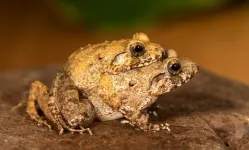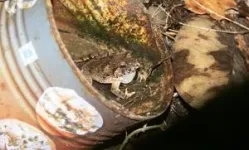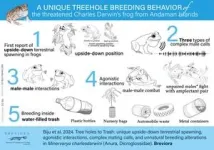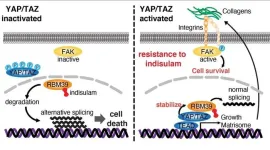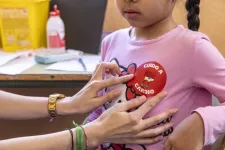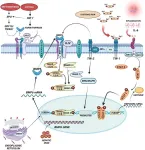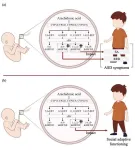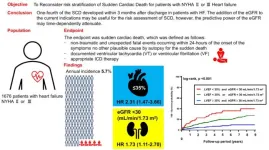(Press-News.org) A team of biologists from the University of Delhi and Zoological Survey of India, Harvard University, and the University of Minnesota has discovered a unique breeding behavior in a species of frog endemic to the Andaman Islands of India. In a new study published in the Harvard Museum of Comparative Zoology’s journal Breviora, scientists describe a combination of traits that makes reproduction in this frog unique.
The Andamanese Charles Darwin’s frog, Minervarya charlesdarwini, belongs to the family Dicroglossidae, a large radiation of Asian frogs that comprises over 220 species. Charles Darwin’s frogs naturally breed as well as deposit terrestrial eggs above the water surface on the inner walls of water-filled tree cavities or root buttresses. Hatchlings then drop into the water below and complete their development through a free-swimming tadpole stage.
The posture of the mating pair at the time of egg-laying also makes Charles Darwin’s frog unique: the pair orient themselves in a vertical, upside-down posture on the tree cavity walls with their bodies completely out the water.
“Upside-down spawning is the most remarkable behavior in this frog. No other frog is known to lay terrestrial eggs inside tree holes in an upside-down position. This discovery is fundamental for understanding how the species interacts with its environments and which habitats are essential for its survival. Such specialized traits also yield insights into the evolution of reproductive modes and behaviours among anuran amphibians,” said Professor S. D. Biju of the University of Delhi, who led the study and is currently a Fellow at the Harvard Radcliffe Institute and an associate of Harvard’s Museum of Comparative Zoology.
The uniqueness of this frog does not end there. Male frogs produce complex advertisement calls comprising three different call types for attracting females. They also produce an aggressive call. When aggressive vocalizations fail to ward off competing males, physical combat begins. These fights include kicking and boxing using hands and legs, and biting of body parts or even the entire head. Males compete aggressively to mate with females.
If a male successfully mounts a female, nearby unpaired males may physically fight with the amplectant pair. They may even try to insert their head between the bodies of the pair from the back side to separate them. The defending male often kicks the intruding males with his hind legs. Simultaneously, and to avoid attacks, the female climbs the wall of the tree hole with the male on her back. The study suggests that the upside-down spawning behaviour in this frog may have evolved as a means of preventing aggressive unpaired males from displacing the amplectant pair from behind and disrupting egg-laying.
“This finding is an example of the remarkable diversity of amphibians and reproductive behaviors that are still unknown to science, especially from unexplored regions in biodiversity hotspots of tropical Asia.” said study co-author Professor James Hanken, Curator of Herpetology at the Museum of Comparative Zoology and Professor of Biology in Harvard’s Department of Organismic and Evolutionary Biology.
Although Minervarya charlesdarwini appears to be an obligate phytotelm-breeder, the research team frequently observed frogs breeding in unnatural sites in disturbed forests, ranging from artificially watered plastic sapling bags in adjacent plant nurseries to rain-filled, discarded plastic, glass or metal containers left as trash at the forest edge. The lack of adequate breeding sites due to habitat loss and competition for limited resources may be driving the Charles Darwin’s frog to breed in such unnatural sites. However, this species may not be able to survive in the face of increasing human dominance and rapidly changing landscapes on the small islands where they live.
The study calls for increased attention to the conservation of this endemic and threatened species (currently IUCN Red listed as “Vulnerable”), and to protection of its specialized and vulnerable microhabitats to maintain adequate availability of natural breeding sites.
“The frogs’ use of trash for breeding is both surprising and worrying. We now need to know its causes and long-term consequences, and devise ways to protect the natural breeding sites that are critical for survival of the species,” said Sonali Garg, a Biodiversity Postdoctoral Fellow at Harvard’s Museum of Comparative Zoology, who co-led the study.
The field-based project was carried out over three years in the remote islands of the Andaman archipelago, which lies in the Bay of Bengal. Researchers spent over 55 nights during the monsoon season to study the secretive reproductive behavior of these tiny frogs. The findings are published in “Tree holes to trash: unique upside-drown terrestrial spawning, agonistic interactions, complex mating calls and unnatural breeding alteration in Minervarya charlesdarwini (Anura, Dicroglossidae),” which appears in the current issue (July 2024) of Breviora.
Informational video: https://tinyurl.com/bnbwbxnz
END
From tree holes to trash
Discovery of a unique upside-down spawning behavior in Charles Darwin’s frog of India
2024-07-29
ELSE PRESS RELEASES FROM THIS DATE:
Despite risk, many unsure of temperature to heat food to prevent illness
2024-07-29
PHILADELPHIA – With bird flu virus detected in cow’s milk, U.S. health authorities have warned the public against potential sources of exposure, including drinking raw or unpasteurized milk, and have reiterated a general warning that consuming uncooked or undercooked poultry or beef products can make you sick.
Relatively few people say they drink raw milk. Only 3% of U.S. adults report having consumed raw milk in the past 12 months, while 4% were not sure whether they had, according to a new nationally representative Annenberg Public Policy Center health survey of nearly 1,500 empaneled U.S. adults conducted in July.*
But many more people say they do ...
YAP/TAZ interactions can confer resistance to anti-tumor drug indisulam
2024-07-29
In a healthy human body, tissue growth and development are coordinated by many different mechanisms. Within our bodies, these mechanisms regulate the healthy growth of cells, limit their size and number, and control the timing of cell death through apoptosis. However, when these regulatory pathways are altered, or break down, cell growth and proliferation may increase beyond what is safe and this can lead to cancer. One critical cell growth regulatory mechanism is the Hippo signaling pathway. This pathway regulates the expression of several genes that control cell proliferation ...
Asbestos-related cancer: exaggerated risk perception
2024-07-29
Asbestos, a group of naturally occurring fibrous minerals, has been historically used for its durability and resistance to heat. Despite its advantageous properties, asbestos is a well-documented carcinogen, linked to diseases such as lung cancer (LC) and malignant pleural mesothelioma (MPM). The controversy surrounding the degree of carcinogenicity of different asbestos types, especially chrysotile versus amphibole asbestos, continues to influence scientific and regulatory discussions. This review delves into the various aspects of asbestos-related research, focusing on historical context, risk assessment, environmental ...
Gropp, former NCSA leaders selected for HPCwire’s inaugural ‘35 Legends’ list
2024-07-29
NCSA Director Bill Gropp and two former Center directors were chosen for the first-ever HPCwire “35 Legends” list in celebration of the publication’s 35th anniversary.
Thirty-five honorees will be announced each year, selected by HPCwire editors and advisors based on their contributions to the high-performance computing community over the past 35 years and celebrated for the different ways they’ve helped move HPC forward.
Gropp, NCSA’s Founding Director Larry Smarr and Former Director Daniel Reed were among the first 17 honorees announced in July. The remaining HPCwire 35 Legends will be ...
The sooner the better: teaching healthy habits in elementary school reduces abdominal fat
2024-07-29
A study led by the Centro Nacional de Investigaciones Cardiovasculares (CNIC) and Fundación SHE, supported by “la Caixa” Foundation, demonstrates that teaching healthy habits through classroom activities helps to prevent the accumulation of abdominal fat during the first school years.
The study, published in the Journal of the American College of Cardiology (JACC), is one of the largest contemporary school-based health promotion studies and has one of the most extensive participant follow-up schedules.
The conclusions are clear: early intervention to promote healthy habits in elementary school children can be more ...
Exploring the impact of iron overload on mitochondrial DNA in β-thalassemia
2024-07-29
β-Thalassemia is a genetic disorder characterized by reduced or absent synthesis of the beta chains of hemoglobin, leading to ineffective erythropoiesis and severe anemia. Patients with transfusion-dependent β-thalassemia (TDT) require regular blood transfusions to maintain adequate hemoglobin levels. Non-transfusion-dependent thalassemia (NTDT) patients manage their anemia without regular transfusions but still experience significant health complications. Iron overload is a common and severe complication in both TDT and NTDT patients ...
Fatty acids in umbilical cord blood might cause autism spectrum disorder
2024-07-29
Autism spectrum disorder (ASD) is a neurodevelopmental disorder that affects learning capability and social behavior of people. Over the past few decades, awareness regarding ASD has increased, especially regarding its prevalence and effect on the lives of people diagnosed with ASD. However, several aspects related to ASD are not well understood, leaving much to be explored.
Although the exact causes of ASD are unclear, currently available evidence points to neuroinflammation as a major factor. Several studies in mouse models of ASD have hinted at the importance of polyunsaturated ...
Kidney dysfunction may predict sudden cardiac death in patients with heart failure
2024-07-29
Patients with congestive heart failure (CHF) having a compromised blood supply, are at greater risk of sudden cardiac death (SCD). With an estimated incidence as high as 22% among these patients, current clinical guidelines recommend using implantable cardioverter defibrillators (ICDs) to help mitigate the risk of SCD.
Although the application of ICDs in patients with CHF is backed by substantial evidence, these studies did not include people with chronic kidney disease (CKD), who are an important clinical population. In other ...
Virus that causes COVID-19 is widespread in wildlife, Virginia Tech scientists find
2024-07-29
SARS-CoV-2, the virus responsible for COVID-19, is widespread among wildlife species, according to Virginia Tech research published Monday (July 29, 2024) in Nature Communications. The virus was detected in six common backyard species, and antibodies indicating prior exposure to the virus were found in five species, with rates of exposure ranging from 40 to 60 percent depending on the species.
Genetic tracking in wild animals confirmed both the presence of SARS-CoV-2 and the existence of unique viral mutations with lineages closely matching variants circulating in humans at the time, further supporting human-to-animal transmission, the study found.
The highest exposure to SARS ...
Study tracks exposure to air pollution through the day
2024-07-29
There are significant differences in how much people are exposed to air pollution, according to a new study co-authored by MIT scholars that takes daily mobility into account.
The study, based in the Bronx, New York, does not just estimate air pollution exposure based on where people live or work, but uses mobile data to examine where people go during a typical day, building a more thorough assessment of the environment’s impact on them.
The research finds exposure to particulate matter 2.5 microns or bigger rises by about 2.4 percent when daily travel patterns are taken into account.
“One of the main strengths of the study is that we ...
LAST 30 PRESS RELEASES:
Hospitals acquired by real estate investment trusts associated with greater risk of bankruptcy, closure
City of Hope scientists study rare disorder to uncover mechanism and hormone regulation underlying fatty liver disease and sweet aversion
Your genes may influence gut microbiome of others, rat study shows
‘Personality test’ shows how AI chatbots mimic human traits – and how they can be manipulated
Global food systems driving twin crises of obesity and global heating
Osaka Medical and Pharmaceutical University researchers capture real-time molecular movies of enzyme catalysis
Could your genes influence the gut microbiome of others?
Clues to Alzheimer’s disease may be hiding in our ‘junk’ DNA
Study reveals that the body uses different sensors to detect cold in the skin and in internal organs
iPS cells from dish to freezer and back
Deep neural networks enable accurate pricing of American options under stochastic volatility
Collective risk resonance in Chinese stock sectors uncovered through higher-order network analysis
Does CPU impact systemic risk contributions of Chinese sectors? Evidence from mixed frequency methods with asymmetric tail long memory
General intelligence framework to predict virus adaptation based on a genome language model
Antibiotic resistance is ancient, ecological, and deeply connected to human activity, new review shows
Vapes, pouches, heated tobacco, shisha, cigarettes: nicotine in all forms is toxic to the heart and blood vessels
From powder to planet: University of Modena engineers forge a low-carbon future for advanced metal manufacturing
Super strain-resistant superconductors
Pre-school health programme does not improve children’s diet or physical activity, prompting call for policy changes, study finds
Autumn clock change linked to reduction in certain health conditions
AI images of doctors can exaggerate and reinforce existing stereotypes
Where medicine meets melody – how lullabies help babies and parents in intensive care
We may never be able to tell if AI becomes conscious, argues philosopher
AI video translation shows promise but humans still hold the edge
Deep ocean earthquakes drive Southern Ocean’s massive phytoplankton blooms, study finds
Without campus leftovers to pick through, the beaks of this bird changed shape during the pandemic
High-dose antibiotic does not reduce mortality in tuberculous meningitis
How many insects fly in the sky above the USA?
Could cheese protect your brain health?
Who faces more difficulty recovering from stroke?
[Press-News.org] From tree holes to trashDiscovery of a unique upside-down spawning behavior in Charles Darwin’s frog of India
